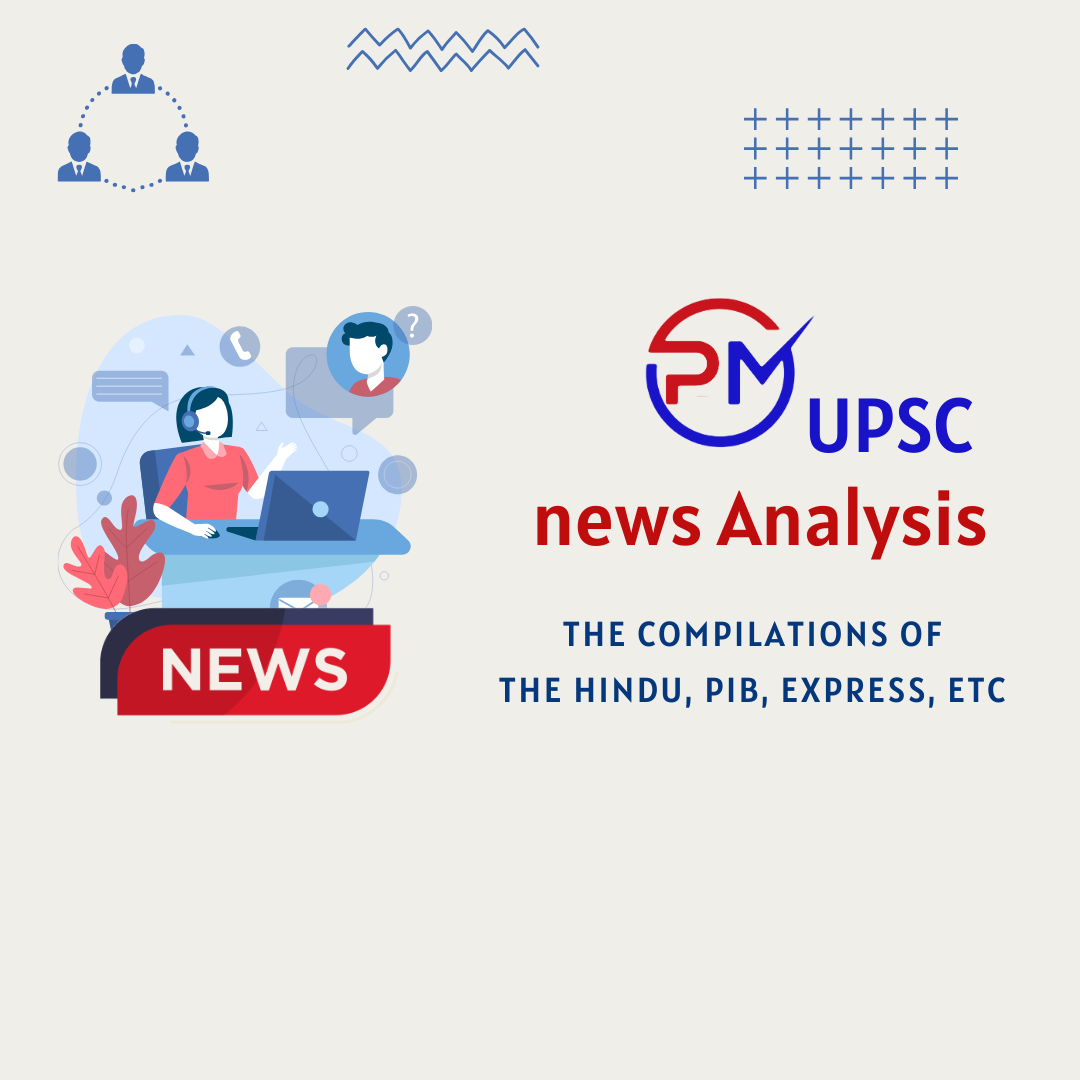Sub-categorisation of Scheduled CastesSyllabus: GS2/Polity and Governance; Government Policy and InterventionContext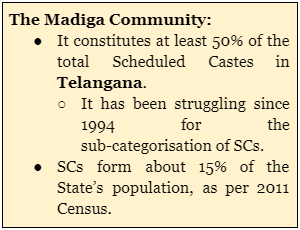
The Union government has formed a committee to ensure equitable distribution of benefits to Scheduled Castes (SCs) across the country.- The sub-categorisation of SCs comes after the Prime Minister’s promise to look into the demand raised by the Madiga community of Telangana.
Sub-Categorisation within Scheduled CastesIt is to identify and help the most backward among the SCs.In the last two decades, multiple states like Punjab, Bihar, and Tamil Nadu have tried to bring in reservation laws at the state level to sub-categorise SCs.In the last two decades, States like Punjab, Bihar, and Tamil Nadu have tried to bring in reservation laws at the State level in a bid to sub-categorise Scheduled Castes.Legality of Sub-categorisationE. V. Chinnaiah v State of Andhra Pradesh (2004): The Supreme Court through its 5-Judge Bench held that once a community is included in the Presidential List for Scheduled Castes under Article 341 of the Constitution, they become part of a single larger class of people, casting a wide net for the purposes of reservation.- It held that the State did not have the legislative power to create sub-classifications within this single class and that such an action would violate the Right to Equality.
However, all plans are held up in courts as the Supreme Court forms its larger Constitution Bench (in Davinder Singh Case) to decide the matter.- The issue of sub-classification in reservations has been pending before a 7-Judge Constitution Bench for nearly two years without a hearing.
Arguments favouring sub-categorisation within Scheduled CastesGraded Inequalities: The principal argument for sub-categorisation of SCs has been the graded inequalities among SC communities.- The thrust of it has been that even among the marginalised, there are communities that have lesser access to basic facilities.
Unequal Representation: Some communities are more backward and have less representation than others.- For instance, the Madiga community has claimed that the benefits, including that of reservation, meant for the SC category had been cornered by the Mala community, with the Madigas being left out.
Legal Standpoint: A five-judge Bench headed by Justice Arun Mishra has affirmed the competence of the States to give preferential treatment to the weakest among the Scheduled Castes without depriving other castes of any benefit.- The Court has noted that the Scheduled Castes list contains many castes and cannot be treated as a homogeneous group.
Equitable Distribution of Benefits: The Union government has formed a committee of Secretaries to evaluate and work out a method for the equitable distribution of benefits, schemes, and initiatives to the most backward communities amongst the over 1,200 Scheduled Castes across the country.| Committees for Sub-categorisationCommittee of Secretaries: It is a five members committee comprising the Secretaries of the Home Ministry, Law Ministry, Tribal Affairs Ministry, and Social Justice Ministry and it is chaired by the Cabinet Secretary.Mandate: To look at strategies like special initiatives, focusing existing schemes towards them, etc.The Committee needs not to deviate into policy matters like reservation or break-up of SC quota for employment and education.There is no deadline given to present its findings. However, it has been asked to do so at the earliest.Previous Commissions:Justice P. Ramachandra Raju Commission (1996)National Commission (2007) |
Arguments against sub-categorisation within Scheduled CastesThese are primarily based on the legal and practical challenges associated with it.Legal Challenges: The Supreme Court held that the State did not have the power to unilaterally sub-categorise communities in the list of SCs or Scheduled Tribes (STs).-
The Constitution has provided that these lists can only be made by Parliament and notified by the President.
Data of socio-economic status: The population data related to SC, ST, and OBC categories are not updated since the 2011 census.- It hampers the objective and scientific basis for sub-categorisation.
Untouchability: The social and educational backwardness cannot be applied to Scheduled Castes and Scheduled Tribes. The special treatment is given to the SCs due to untouchability with which they have suffered since ages.| Scheduled Castes in IndiaAs per the 2011 Census, the total population of SCs in India is 16.6% (16.2% in 2001 Census) of the total population of India.Article 341 of Constitution of India defines Scheduled Caste with respect to any State or Union Territory.Constitutional ProvisionsArticle 14: Guarantees equality before law.Article 15 (4): The state is empowered to make any special provision for the advancement of any socially and educationally backward classes of citizens or for the scheduled castes.Article 16(4), 16 (4A) and 16 (4B): Provide for reservation in posts and services.Article 17: Untouchability stands abolished and its practice in any form is forbidden.Article 23: It emphasises the importance of protecting individual freedom and dignity.Article 24: It prohibits the employment of children below the age of 14 years in any factory, mine, or hazardous occupation.Article 46: Promotion of educational and economic interests of Scheduled Castes, Scheduled Tribes and other weaker sections.Article 330: Reservation of seats for Scheduled Castes and Scheduled Tribes in the House of the People.Article 335: It permits laws that reduce the requirements or relax qualifications for members of SC/ST communities in appointments to public services and posts.Other Statutory ProvisionsRFCTLARR Act, 2013: Special provisions have been made for Scheduled Castes and Scheduled Tribes under Sections 41 and 42 of the RFCTLARR Act, 2013 which protect their interests.Scheduled Castes and Scheduled Tribes (Prevention of Atrocities) Act, 1898: This legislation was designed to provide a measure of protection to Scheduled Castes and Scheduled Tribes and to enforce their rights. |
ConclusionThe Constitution of India does not prohibit the Parliament to sub-categorise SCs but it needs to justify by the government that this move would be a 100% count of all castes – a caste census of each community and sub-community and their respective socio-economic data. The government should focus on the equitable distribution of benefits, schemes and initiatives to SCs population in India, as mandated by the Constitution and other Statutory provisions.Source: THIran-Pakistan ConflictSyllabus:GS2/International RelationsContextPakistan has launched missile strikes into Iran under Operation Marg Bar Sarmachar (Death to Insurgents), following Iran’s missile strikes in Pakistan.Where is Balochistan?Balochistan is a region with a distinct cultural and historical identity, divided between three countries: Pakistan, Iran and Afghanistan.- The 909-km Iran-Pakistan border, known as the Goldsmith Line, stretches from a tripoint with Afghanistan to the northern Arabian Sea.
The region takes its name from the Baloch tribe. Roughly 9 million ethnic Baloch live on either side of the line, in the Pakistani province of Balochistan, and the Iranian province of Sistan and Baluchestan. The largest portion of the region is in south-western Pakistan. It is Pakistan’s largest province, comprising 44% of the total landmass.- It is arid, and the country’s least inhabited and least economically developed region.
Issues of BalochistanEconomic issues: The people of Balochistan had long felt their region was neglected in terms of development and political representation, fuelling resentment towards the ruling establishment.Political issues: In Pakistan, the Baloch are an ethnic minority physically and politically distant from the Punjabi-dominated regime and also in Iran, the majority-Sunni Baloch are a religious minority who have been persecuted by the state.Demand for separate state: Their marginalization in both countries in subsequent years fuelled several separatist movements for a “Greater Balochistan” nation state.Militant groups involvedJaish Al-Adl (JAA): The Sunni separatist militant group operates freely from Balochistan and is fighting for independence in Iran’s Sistan and Baluchestan province. Baloch Liberation Front and Baloch Liberation Army: Both are Iran-based hideouts of two Baloch militant groups deemed as “terrorist organizations” by Pakistan.Relations Between Iran and PakistanBefore the 1979 Islamic Revolution in Iran, both countries were
firmly allied to the United States.In 1955, both of them joined the Baghdad Pact, later known as the Central Treaty Organization (CENTO), a military alliance modeled on NATO.However an ultra-conservative Shiite regime took power in Iran and Sunni -majority Pakistan was undergoing its own Islamisation under military dictator Gen Zia-ul-Haq. In this way the two countries found themselves at opposite ends of the sectarian divide.The Baloch militant insurgency has been a long-running source of tensions between Pakistan and Iran. Both the nations often accused each other of harboring separatist terrorists.India’s Stakes in the regionTraditionally India has stayed neutral in the conflicts within the Middle East. However, the fragility of the Baloch frontier, China’s strategic presence in Balochistan along with growing role in the Gulf are of deep concern to India. Also India has invested in Chabahar port lying the Makran coast of Sistan and Baluchistan Province is of concern for India.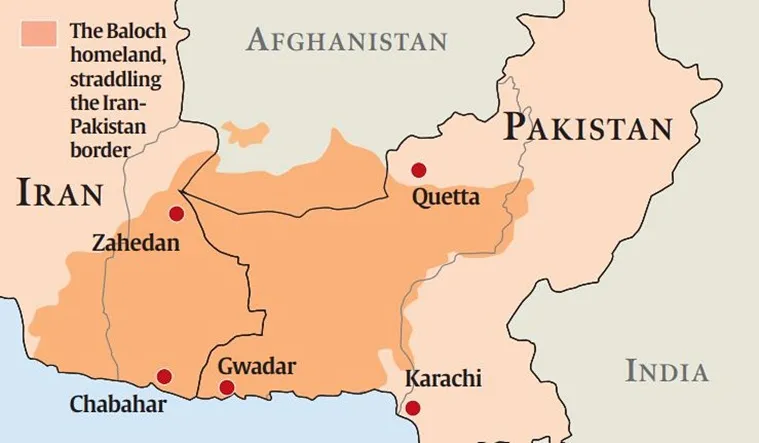 Source: IEScience Communication in IndiaSyllabus: GS1/Society, GS3/Science and TechnologyIn ContextCoverage was an exemplar of the public communication of advanced science.What is Science Communication?Science communication involves all forms of communication around science, scientific work, its outcomes, discussions on its ethical, societal, or political impacts, and direct conversations with scientists as well as diverse audiences. ‘Science communication’ is an umbrella term that also includes the exchange of scientific knowledge, institutional outreach, and public engagement with science.Role of Science Communication for Society in IndiaDuring the COVID-19 pandemic, even as governments implemented disaster management laws, the States’ as well as experts’ communication of scientific and healthcare-related information became significant.
Source: IEScience Communication in IndiaSyllabus: GS1/Society, GS3/Science and TechnologyIn ContextCoverage was an exemplar of the public communication of advanced science.What is Science Communication?Science communication involves all forms of communication around science, scientific work, its outcomes, discussions on its ethical, societal, or political impacts, and direct conversations with scientists as well as diverse audiences. ‘Science communication’ is an umbrella term that also includes the exchange of scientific knowledge, institutional outreach, and public engagement with science.Role of Science Communication for Society in IndiaDuring the COVID-19 pandemic, even as governments implemented disaster management laws, the States’ as well as experts’ communication of scientific and healthcare-related information became significant.- Science communication in a pandemic is intended to promote public compliance with good ‘pandemic habits’ like physical distancing, masking, and vaccination.
It will help science and scientific cultures penetrate India’s diverse society, and to transform it into a nation of scientific thinking and scientifically aware people.It is an effective tool for extending scientific boundaries and gaining wide public support for important research and development, which are indispensable for society’s development.Government Initiatives to Encourage Scientific CommunicationIn 1951, the government established the Publications & Information Directorate (PID) under the Council of Scientific and Industrial Research (CSIR).- The PID published the national science magazines Vigyan Pragati (Hindi), Science Reporter (English), and Science Ki Duniya (Urdu).
The government followed up with an attempt to define India’s scientific heritage and the cause of promoting science education through the Birla Industrial and Technological Museum in Calcutta in 1959. In 1976, Parliament passed the 42nd amendment to the Constitution.- This included Article 51 A(h) which states “It shall be the duty of every citizen of India to develop a scientific temper, humanism and the spirit of enquiry and reform.”
The sixth Five Year Plan (1980-1985) promoted the need to popularise science and nurture scientific thinking in India, and established the National Council for Science and Technology Communication (NCSTC). In 1989, the Department of Science and Technology set up Vigyan Prasar, an autonomous organisation to popularise science at large.Modern Scenario: In 2021, the government set up the CSIR-National Institute of Science Communication and Policy Research (CSIR-NIScPR) by merging two previous institutions.- Nearly all national science funding agencies have science communication divisions, which issue press releases, conduct social media campaigns, and garner support for exhibitions, popular lectures, etc.
How India can Improve Science Communication?Training: Scientists should be trained in the art of science communication while journalists must be oriented towards at least the basic understanding of sciences and its
methodology. Degree Programmes: Expanding science communication degree programmes in India at the masters’ and doctoral levels could support training and research in the field.- This will also lead to a trained cadre of science communicators with an informed understanding of the needs, perspectives and the consequences of their work in diverse educational, linguistic, and cultural contexts in the country.
Recognising Scientists: Rewarding scientists for communicating science, nourishing public engagement, and translating research papers to regional languages.Creating Platforms: More platforms should be created to engage scientists and media practitioners to have close dialogues on issues pertaining to scientific developments.Large-scale science communication strategy: This could start with a professional organisation with experts from many fields that works closely with government-level science departments and offices.- These frameworks will have to cut across disciplines – of science, medicine, disaster-management, national security, and diplomacy groups as well as media formats.
Way AheadGiven the role of scientific solutions to national challenges – such as antimicrobial resistance, air pollution, and energy diversification – India needs a large-scale science communication strategy. When the journalists and the scientific community exchange communication on issues related to science, it creates a mutual understanding, which in turn yield positive outcomes. More seriously planned agenda and policies for science communication in a truly transparent manner are a pre-requisite to engage and speed-up science communication. Source: THNational Quantum Mission Syllabus: GS3/Science and TechnologyIn ContextThe government will set up a coordination cell to implement the National Quantum Mission (NQM) with a focus on establishing four technology hubs.AboutThe NQM is expected to set up four mission hubs in quantum computing, quantum communication, quantum sensing and metrology, and quantum materials and devices.It will essentially be a consortium of academia, research and development labs and industry.Mission Coordination Cell (MCC)The MCC will be set up as a coordinating agency for the Mission and will work in coordination with the Mission Secretariat, DST.It will function under the overall supervision and guidance of Mission Technology Research Council (MTRC).National Quantum Mission (NQM)The government approved the National Quantum Mission (NQM) in 2023 from 2023-24 to 2030-31.Aim: To seed, nurture and scale up scientific and industrial R&D and create a vibrant & innovative ecosystem in Quantum Technology (QT).- This will accelerate QT led economic growth, nurture the ecosystem in the country and make India one of the leading nations in the development of Quantum Technologies & Applications (QTA).
Objectives: The Mission objectives include developing intermediate-scale quantum computers with 50-1000 physical qubits in 8 years in various platforms like superconducting and photonic technology.- Satellite-based secure quantum communications between ground stations over a range of 2000 kilometers within India, long-distance secure quantum communications with other countries, inter-city quantum key distribution over 2000 km as well as multi-node Quantum networks with quantum memories.Developing magnetometers with high sensitivity in atomic systems and Atomic Clocks for precision timing, communications, and navigation. It will also support the design and synthesis of quantum materials such as superconductors, novel semiconductor structures, and topological materials for the fabrication of quantum devices. Single photon sources/detectors, and entangled photon sources will also be developed for quantum communications, sensing, and metrological applications.
Implementation: Setting up of four Thematic Hubs (T-Hubs) in top academic and National R&D institutes in the domains – Quantum Computing, Quantum Communication, Quantum Sensing & Metrology and Quantum Materials & Devices.- The hubs will focus on generation of new knowledge through basic and applied research as well as promote R&D in areas that are mandated to them.
Significance: NQM has the potential to elevate the country’s Technology Development ecosystem to a level of global competitiveness.- The Mission would greatly benefit various sectors including communication, health, financial, energy with applications in drug design, space, banking, security etc. The Mission will also provide a huge boost to National priorities like Digital India, Make in India, Skill India and Stand-up India, Start-up India, Self-reliant India and Sustainable Development Go
als (SDG).
| Quantum TechnologyQuantum technology is a rapidly advancing field that leverages the principles of quantum mechanics to develop new technologies with unprecedented capabilities. Quantum mechanics is the branch of physics that studies the behavior of particles at the quantum level, where classical physics no longer applies. Quantum technology harnesses the unique properties of quantum systems, such as superposition and entanglement, to perform tasks that were previously thought impossible or significantly enhance existing capabilities.Four domains of quantum technologies:Quantum communication: It applies the properties of quantum physics to provide better security and improved long-distance communications.Quantum simulation: It refers to the use of a quantum system to simulate the behavior of another quantum system. Quantum computation: It is a field of computing that utilizes the principles of quantum mechanics to perform certain types of calculations more efficiently than classical computers.Quantum sensing and metrology: It leverage the principles of quantum mechanics to achieve highly precise measurements. |
Source: PIBIndia’s First Graphene Centre Syllabus: GS3/Developments in Science and TechnologyContextThe Union government recently launched India’s first graphene centre (IICG) in Kerala.The centre was established to foster research and development, product innovation and capacity building in the area of graphene and 2D material systems.About the GrapheneGraphene, a single layer of carbon atoms arranged in a honeycomb lattice, holds immense potential for revolutionizing various industries due to its extraordinary properties.Properties: It is the world’s thinnest, strongest, and most conductive material of both electricity and heat.- It conducts electricity better than copper.It is 200 times stronger than steel but six times lighter. It is almost perfectly transparent as it absorbs only 2% of light.It is impermeable to gases, even those as light as hydrogen and helium.
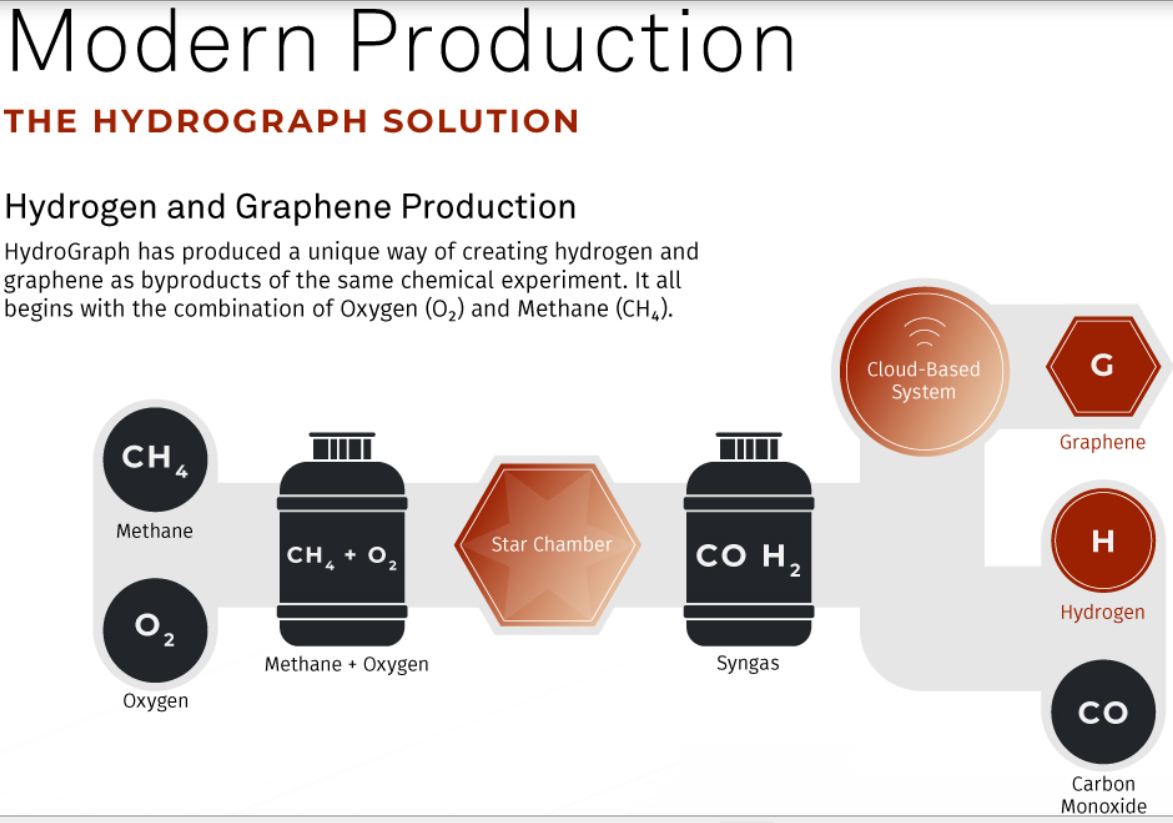 ApplicationsGraphene composites are used in automotive, sports equipment and construction. It is used for high-performance batteries and super-capacitors, touchscreens, and conductive inks. Graphene-based sensors are used for environmental monitoring, healthcare and wearable devices. Graphene oxide membranes are used for water purification and desalination.Graphene-based masks were made during COVID.Graphene is important for defence and aerospace as well. Its exceptional strength makes it a promising material for armour and ballistic protection. Graphene has the potential to absorb and dissipate electromagnetic waves, making it valuable for developing stealth coatings and materials that reduce radar signatures and electromagnetic interference. Graphene is highly sensitive to environmental changes, which makes it an excellent candidate for sensing chemical and biological agents, explosives, radiation, and other hazardous substances. Besides, graphene-based materials can also protect us against chemical and biological attacks. About the Centre of Excellence (CoE) in IIoT SensorsAlong with the IICG, the Centre of Excellence (CoE) in IIoT Sensors was also launched.It aims to catalyse the development of sensors within the realm of Intelligent IoT systems covering a broad spectrum of applications of intelligent sensors in networks and devices.
ApplicationsGraphene composites are used in automotive, sports equipment and construction. It is used for high-performance batteries and super-capacitors, touchscreens, and conductive inks. Graphene-based sensors are used for environmental monitoring, healthcare and wearable devices. Graphene oxide membranes are used for water purification and desalination.Graphene-based masks were made during COVID.Graphene is important for defence and aerospace as well. Its exceptional strength makes it a promising material for armour and ballistic protection. Graphene has the potential to absorb and dissipate electromagnetic waves, making it valuable for developing stealth coatings and materials that reduce radar signatures and electromagnetic interference. Graphene is highly sensitive to environmental changes, which makes it an excellent candidate for sensing chemical and biological agents, explosives, radiation, and other hazardous substances. Besides, graphene-based materials can also protect us against chemical and biological attacks. About the Centre of Excellence (CoE) in IIoT SensorsAlong with the IICG, the Centre of Excellence (CoE) in IIoT Sensors was also launched.It aims to catalyse the development of sensors within the realm of Intelligent IoT systems covering a broad spectrum of applications of intelligent sensors in networks and devices.- The IoT is a network of interconnected devices that communicate and share data with each other through the internet.
Source:
IENews in ShortVeerbhadra TempleSyllabus :GS 1/Art and Culture In NewsThe Prime Minister performed darshan and puja at Veerbhadra Temple in Andhra Pradesh.  About Veerbhadra TempleIt is also known as the Lepakshi temple.
About Veerbhadra TempleIt is also known as the Lepakshi temple.- The literal meaning of the word is Lepa + Akshi, an embalmed eye or a painted eye.
It is dedicated to Veerabhadra (the fiery incarnation of Lord Shiva).- According to Hindu mythology, Daksha insulted his daughter Sati and her husband Shiva at a grand sacrifice he had organised. Unable to bear the humiliation, Sati immolated herself.To avenge her form of the wrathful Veerabhadra.
Notable features: It has shrines dedicated to Shiva, Vishnu, Papanatheswara, Raghunatha, Rama and other deities.- It exhibits the interchange of human values and socio-cultural traditions from 11th century Chalukyan Period to 15th century early Vijayanagara period.
| Do you know ?The Sri Veerabhadra Swamy temple and the Monolithic Bull (Nandi) at Lepakshi in Anantapur district known for the Vijayanagara sculpture and painting art tradition, have found a place on the tentative list of the World Heritage Committee and the same was published on the Unesco World Heritage Convention website. |
Source:
PIBSomnath: A brief history of the templeSyllabus :GS 1/Art and Culture In NewsAyodhya Priest says ‘incomplete Ram Mandir’ claim is misleading, cites Somnath Temple Pran Pratishtha.
About Somnath temple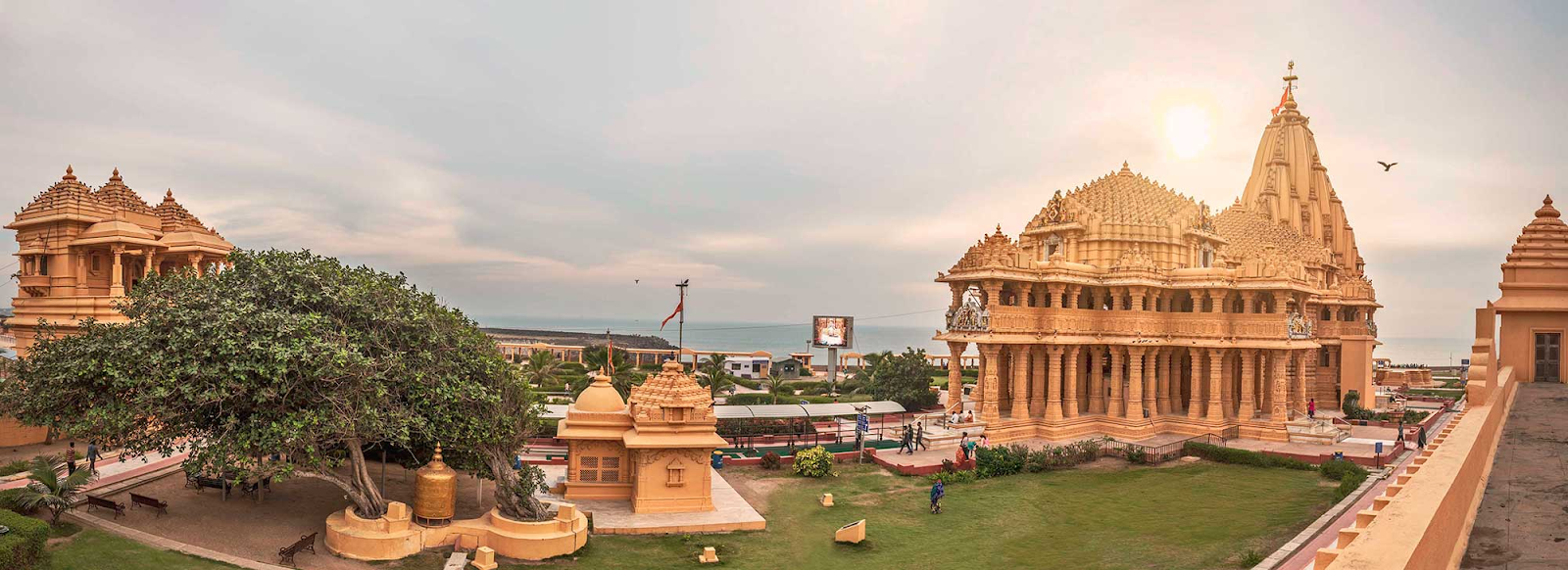 It is located in Prabhas Patan near Veraval in Saurashtra on the western coast of Gujarat.It means “The Protector of the moon god”. It is believed to be the first among the twelve jyotirlinga shrines of Shiva. The site of Somnath has been a pilgrimage site from ancient times on account of being a Triveni sangam (the confluence of three rivers — Kapila, Hiran and Sarasvati. Mahmud Ghazni attack : Mahmud’s last major raid was on Somnath temple in Saurashtra on the western coast of Gujarat in 1025 CEReconstructed several times in the past after repeated destruction by several Muslim invaders and Portuguese
It is located in Prabhas Patan near Veraval in Saurashtra on the western coast of Gujarat.It means “The Protector of the moon god”. It is believed to be the first among the twelve jyotirlinga shrines of Shiva. The site of Somnath has been a pilgrimage site from ancient times on account of being a Triveni sangam (the confluence of three rivers — Kapila, Hiran and Sarasvati. Mahmud Ghazni attack : Mahmud’s last major raid was on Somnath temple in Saurashtra on the western coast of Gujarat in 1025 CEReconstructed several times in the past after repeated destruction by several Muslim invaders and Portuguese- The present temple was reconstructed in Chaulukya style of Hindu temple architecture and completed in May 1951. The reconstruction was completed by Vallabhbhai Patel.
| Mahmud of GhazniMahmud Ghazni invaded India 17 times during AD 1000–1026. Mahmud GhazniHe was Son of Sabuktigin, the founder of Ghazni dynasty & Turkish slave commanderMahmud’s raids into India were only to acquire the famous wealth of India. This wealth wouldhelp him to consolidate his vast rule in Central Asia. He did not wish to establish an empire in India. |
Source: TH
Guruvayur Temple Syllabus: GS1/ Art & CultureContextThe Prime Minister of India recently visited Sree Krishna Temple, Guruvayur.About the templeGuruvayur is home to the historic Sree Krishna Temple, called the Dwaraka of the South. It is among the most revered and popular pilgrimage destinations in Thrissur, Kerala.The temple is built in the traditional Kerala architectural style and the central shrine is believed to have been rebuilt in 1638 C.E.As per tradition, the shrine faces the East with two Gopurams (tower), one in the East and other in the West. In the front and the east side of the Nalambalam (a square shaped column) lie the pillars of light called Deepastambam. There are a number of such light pillars in the temple.One of the most popular offerings at Guruvayoor temple is Thulabharam, where devotees are weighed against bananas, sugar, jaggery and coconuts equivalent to their weight, on a giant pair of scales.Source:
THKashmir’s Dry WinterSyllabus: GS1/ GeographyNewsThe Kashmir Valley and Ladakh are experiencing an unusual and severe dry spell (lack of snowfall) this winter.AboutSnowfall is crucial for the local climate, winter crops and horticulture, availability of waters in streams and rivers, and for the local economy.One of Kashmir’s main winter tourism attractions, Gulmarg, has been bereft of snow this season.- Gulmarg is one of Asia’s largest and highest ski resort towns.
Reasons Western Disturban
ces: Winter precipitation in the Himalayan region is caused mainly by Western Disturbances, which have been showing a declining trend in recent times.- This season there was one feeble western disturbance event in December that did not bring any rains, and another similar one in January.Western Disturbances typically originate as low-pressure systems or cyclones over the Mediterranean Sea. As they move eastwards, they bring significant changes in weather conditions over the Indian subcontinent.
Temperature Rise: The temperature in the regions is rising. For example, Kashmir’s Srinagar temperature on many days are comparable to those of Delhi, sometimes they appear to be even higher.El Nino: It has affected the global atmospheric circulation, and might be contributing to the deficit precipitation in the region as well.ImpactsShort term implications: A dry spell can result in an increase in forest fires, agricultural drought, and a drop in crop production. It can also lead to an early spring, which can cause a reduction in yield.Long-term implications: It includes the generation of less hydroelectricity, an increase in the rate of glacier melting, and an adverse impact on the drinking water supply, since scanty snowfall means very little recharge of groundwater.Source:
IEPakke Paga Hornbill FestivalSyllabus: GS3/Biodiversity, ConservationContext:The 9th edition of the Pakke Paga Hornbill Festival (PPHF) commenced to protect and conserve hornbills.AboutThe Festival was organised at Seijosa, Pakke Kessang District of Arunachal Pradesh.- It is home to four species of hornbills, namely Wreathed, Great Indian, Oriental Pied and the endangered Rufous-necked.The area is the traditional homeland of the Nyishi people, the largest tribal group in the state.
It was organised by the Pakke Tiger Reserve and the Pakke Paga Hornbill Festival Committee, in collaboration with Wildlife Trust of India.| Hornbills BirdsThe hornbills are a family of birds found in tropical and subtropical Africa and Asia.They are typically large-headed, with thin necks, broad wings, and long tails. The plumage is brown or black, usually with bold white markings.India is home to nine species of hornbills.The northeastern region of India has the highest diversity of hornbill species.Great Hornbill: Vulnerable (IUCN Status)Threats:Hornbills are hunted for their casques i.e. upper beak and feathers for adorning headgear.Tribal people hunt them for their parts for rituals and making headgears and other decorations and even as a delicacy.Habitat loss and hunting are major threats.Forest clearance for agriculture. |
Source: DTESoil-powered Fuel CellSyllabus: GS3/Science and TechnologyContext:Recently, scientists have developed a new fuel cell, claiming it can harvest energy from microbes (bacteria) living in the soil. About the Soil-powered fuel cellIt is a new technology that generates power with the help of microbes in the soil instead of chemicals.The microbes release electrons during the decomposition of organic matter. These electrons flow from the anode to the cathode, creating an electric circuit that generates power.It can potentially last forever as long as there is organic carbon in the soil for the microbes to break down.SignificancesIt potentially be used in green infrastructure and precision agriculture applications.It could offer a sustainable, renewable alternative to traditional batteries, which hold toxic, flammable chemicals that leach into the ground and contribute to the ever-growing problem of electronic waste.Source: IEDistress Alert TransmitterSyllabus: GS3/Science and TechnologyContextRecently, the Indian Space Research Organisation (ISRO) upgraded its Distress Alert Transmitter (DAT) as Second Generation DAT (DAT-SG) to aid Search and Rescue Operations in the Maritime Domain.Second Generation DAT (DAT-SG)It can receive messages from the control centre, allowing for the transmission of advance alerts about bad weather, cyclones, tsunamis, or other emergencies.- It can send back an acknowledgement to the fishermen who activate the distress alert, assuring them of incoming rescue.
Information about Potential Fishing Zones to get a good yield in their catch and save time and fuel.It can be connected to mobile phones using Bluetooth, and the messages can be read in the native language using an App on the mobile.The Indian Mission Control Centre (INMCC), a central control centre, has a web based network management system called ‘SAGARMITRA’ which maintains a database of registered DAT-SGs- It helps Maritime Rescue Coordination Centres (MRCCs) to access the information about the boat and coordinate the boat in distress in real time.It helps the Indian Coast Guard to undertake Search & Rescue operations at the time of distress, without any time delay.
The services of DAT-SG are operational on a 24×7 basis.

